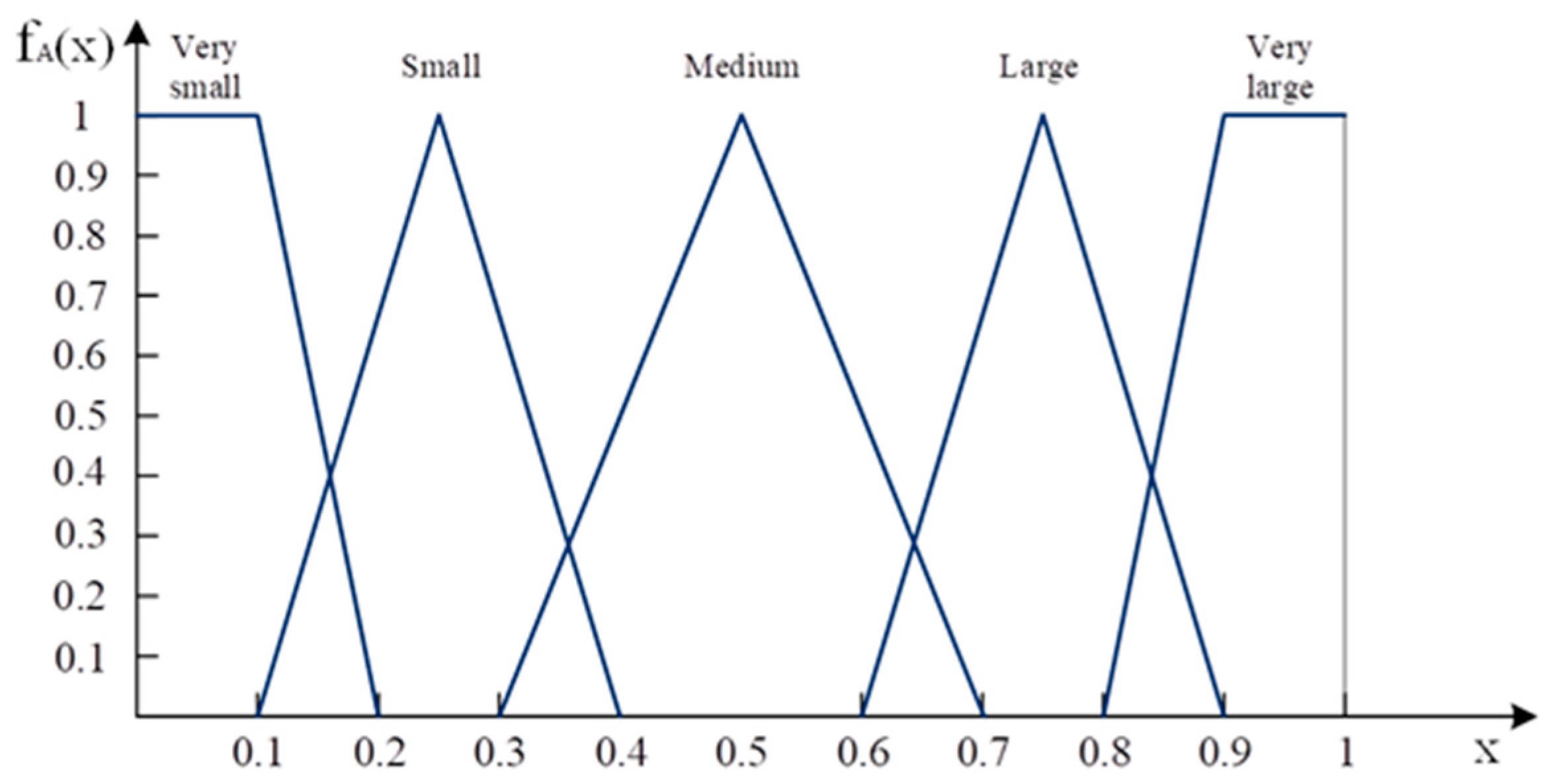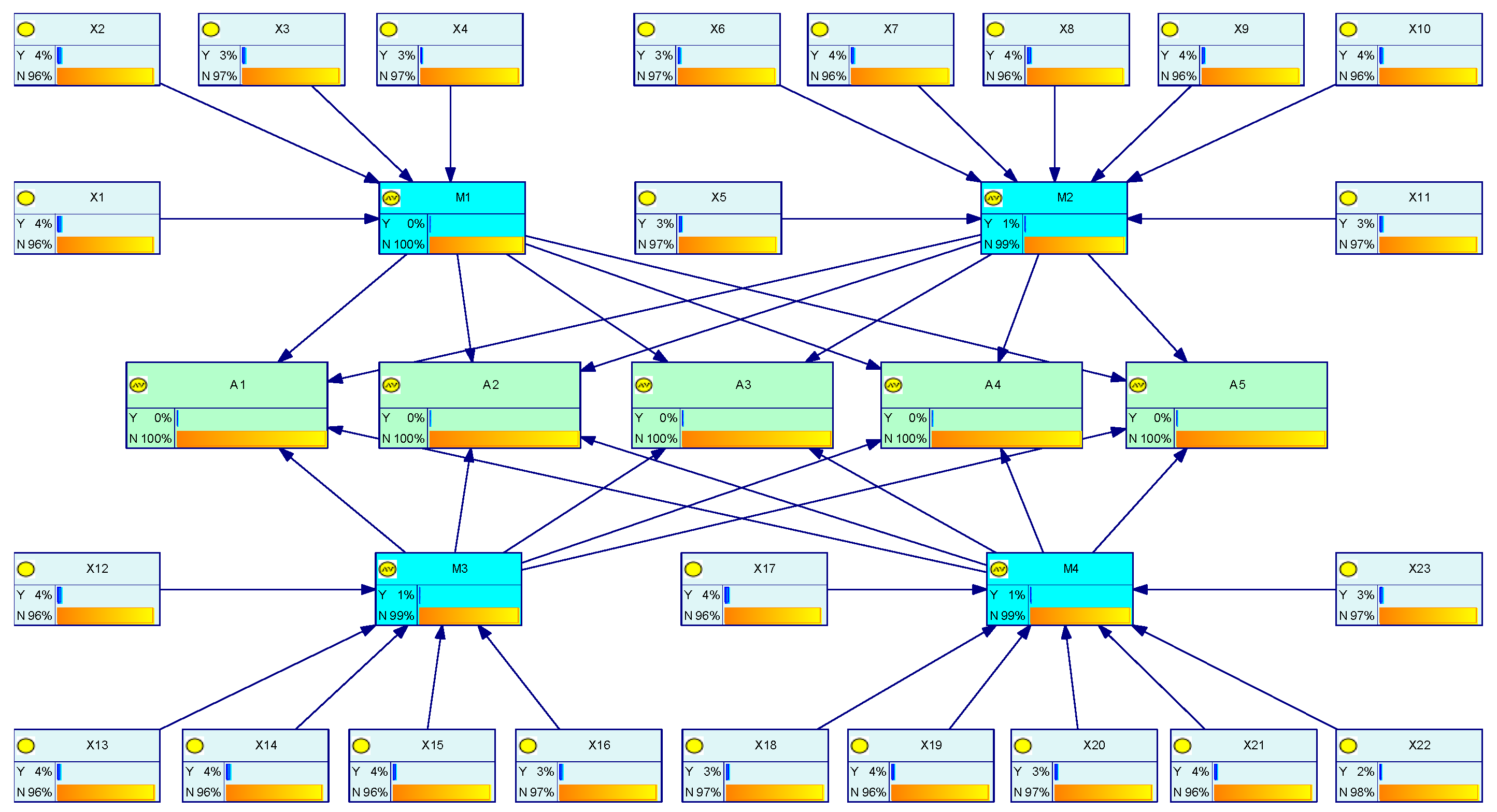4.2. Analysis of HESRCI Inference Using FBU
- (1)
Overall significance of CoP in higher education social responsibility
On the basis of survey data, the fuzzy failure probability of each node can be determined using Equation (1) and subsequently employed as the prior probability within the Bayesian network. Taking node X1 (Human Resource) as an illustrative example, the process for computing the fuzzy failure probability of this specific node is outlined as follows:
Table 3 presents the computed results pertaining to fuzzy numbers for the remaining nodes.
Upon the results of
Table 3, the values of K, fuzzy possibility (FPS) and fuzzy failure probability (FFP) for the node are determined utilizing Equations (3) and (4) and summarized in
Table 4. Taking node X1 (Human Resource) as an example again, its FPS and FFP are computed as follows:
As explained in
Section 3.3 earlier, the calculation of the node’s connection probability follows Formula (6), subsequently leading to the computation of the node’s conditional probability as per Formula (8). Consequently, the resulting connection probabilities for nodes A1–A5 (i.e., the five sections of HESR) and M1–M4 (i.e., the four domains of CoP contribution) are illustrated in
Table 5 and
Table 6, respectively. The process for determining the conditional probability of a specific node is demonstrated below, taking M1 (Resource) as an exemplar. The corresponding results are illustrated in
Table 7, while the rest nodes are computed by following the same process.
Ultimately, based on probabilities calculated upon the respondents’ feedback, the BN inference demonstrates the magnitude of the probability of each node, and this is visualized through GENIE 2.0 software, as depicted in
Figure 6.
The contribution of CoPs within each section of HESR is delineated by the probabilities associated with nodes A1–A5, as presented in
Table 8. This yields the following hierarchical order: A3 > A2 > A4 > A5 > A1.
With the highest probability of 0.101%, the contribution of CoPs to Node A3 (Social Service) underscores their role in connecting higher education activities with societal needs. The findings suggest that the respondents’ experiences of CoPs engagement effectively demonstrate their role in bridging academic institutions with community development, extending beyond the realm of knowledge diversity to address concrete societal demands. Through active participation in community-focused initiatives, CoPs enhance the significance and adaptability of HEIs towards societal advancement, thereby establishing them as essential contributors to public welfare and regional development.
Ranking closely with a probability of 0.098%, CoPs’ influence on the node of A2 (Scientific Research) emphasizes the focus on research driven by technological innovation needs within industries. This result suggests that CoPs contribute to sustaining research excellence in HEIs by fostering collaboration among academics, researchers, and industry experts. Additionally, it highlights the role of government support and investment in enhancing HEIs’ research capabilities, which enables them to compete globally in science and technology. By integrating CoPs, HEIs can expand research outputs and innovations, aligning their goals with industry demands and advancing the role of higher education in driving innovation.
The lowest probability (0.089%) identified within node A1, which pertains to the responsibility for talent cultivation, highlights deficiencies in the existing CoP model’s ability to adequately prepare students for the demands of evolving careers. This observed discrepancy between educational outputs and market expectations implies that CoPs must undergo modifications to more effectively incorporate the development of practical skills and engagement with industry. Such an adaptation necessitates the adoption of more innovative strategies, including the modernization of curricula, the formation of partnerships with industry, and the implementation of teaching methods focused on career preparation to bridge the gap between academic training and the requirements of the workforce. Enhancing this alignment would facilitate HEIs in producing graduates who possess skill sets that more effectively align with the expectations of contemporary employers.
Although assigned with slightly less probability than Scientific Research, the contributions of CoPs to node A4 (Cultural Heritage) and node A5 (International Communications) demonstrate a more extensive impact. These domains exemplify an expansion of CoP activities beyond traditional skill-based learning to incorporate broader psychological and cultural aspects. By fostering cultural preservation and international collaboration, CoPs enable HEIs to cultivate a diverse and globally interconnected academic setting, thereby enhancing cross-cultural competencies and international outreach. This suggests that CoPs play an increasing role in developing well-rounded individuals capable of contributing to both local and global communities.
- (2)
Contributions assessed on the CoP domain level
Table 9 below presents the posterior probabilities of contributions attributable to CoP domains, spanning from M1 of resource supplements to M4 of outputs, in relation to each specific individual social responsibility, A1 through A5.
The findings indicate that the multiple dimensions of CoP’s contribution to advancing higher education social responsibilities follow a consistent order: M2 > M4 > M3 > M1. In addition, the significance of CoP domains to each responsibility sector does not exhibit a uniform consistency. For instance, within the domain of CoP governance, the influence on scientific research (A2) and cultural heritage and innovation (A4) is represented by the highest and lowest scores, respectively. Conversely, the probabilities within the domain of CoP activities (M3) are completely inverted. Similarly, the greatest impacts of additional resources provided by CoP (M1) are observed in talent cultivation (A1), whereas the domain of outputs (M4) exerts the least influence on international communications (A5).
The CoP governance mechanism (M2) is perceived as the most significant contributing factor. Establishing structured governance frameworks with clear collaboration policies, operational standards, and conflict resolution guidelines is essential. Leadership training within CoPs can further support collaborative norms and effective decision-making structures, enhancing CoP stability. Given that CoP governance has a particularly strong impact on scientific research but less influence on cultural heritage, institutions may benefit from adopting tailored governance strategies that align with each CoP’s specific goals. Additionally, a flexible, adaptive approach to CoP management is crucial, enabling institutions to periodically assess and adjust governance, resources, and activities to meet the evolving needs of different responsibility sectors.
Since resource supplementation (M1) contributes the least across all domains, policies should shift from simply increasing resources to strategically deploying resources toward strengthening CoP governance and activity effectiveness. This approach ensures that resources support sustainable engagement, meaningful output generation, and stronger links between CoPs and external demands. Meanwhile, its stronger impacts on talent cultivation (A1) but less influence on international communications (A5) suggests that resources should be strategically allocated based on the primary objectives of each CoP. For example, policymakers may consider channeling more resources to CoPs focused on talent development initiatives, such as industry-aligned training programs, while viewing resource supplementation as less critical for CoPs targeting international outreach, where partnerships and networks may be more influential.
CoP outputs (M4), with posterior probability estimates ranging from 26% to 30%, are identified as the second most pertinent contributor due to their direct impact on enhancing the competency and employment competitiveness of graduates. It is recommended that administrators prioritize output-driven CoPs that facilitate practical learning opportunities, including skill certifications and internships, to strengthen the contribution of CoP outputs.
Variations in the influence of CoP activities (M3) on different HESR sections suggest that a “one-size-fits-all” approach to CoP activities may be insufficient. Administrators should aim to tailor CoP activities to address the unique requirements of each HESR category. For instance, CoPs focused on cultural heritage may benefit from activities that emphasize cultural exchange and preservation, whereas CoPs oriented towards talent cultivation may prioritize skill-building workshops and industry internships.
- (3)
Contributions from individual factors
To ascertain the principal influential factors that facilitate the implementation of social responsibility within higher education, a comprehensive analysis has been conducted at the level of individual factors. The findings pertaining to the associated posterior probabilities are presented in
Table 10,
Table 11,
Table 12 and
Table 13.
Within the domain of CoP resource input, all influential factors show a consistent order in regarding to social responsibility contributions, namely A1 > A5 > A2 > A3 > A4. It indicates that external funding (X2) is the most anticipated contributor, especially for driving programs that foster talent cultivation (A1), facilitate international communication (A5), and advance research (A2). However, the comparatively lower impact of the resource input domain overall indicates that while resources like funding, human resources (X1), and facilities (X3) are foundational, they may not singularly enhance CoP outcomes as much as governance or output-focused domains.
The correspondence between projected financial support and actual contributions may reveal a deficiency in the effective utilization of these resources within CoPs. This observation suggests that although stakeholders prioritize financial and facility support, enhancing their efficacy may necessitate more comprehensive strategies, such as the implementation of robust governance frameworks or enhanced resource management. By optimizing resource allocation, particularly within high-impact domains such as talent cultivation and research, HEIs can more effectively fulfill societal expectations, thereby enhancing CoPs’ contributions to their social responsibilities.
The governance (M2) exerts the most significant impact on talent cultivation with an average 30% probability, and the contribution order of A2 > A1 > A3 > A5 > A4 highlights the critical role of mechanism design and implementation in cross-sectional integration. Specifically, the team building (X9) and resource allocation (X7) mechanisms markedly influence the M2 node, whereas the openness (X5) has a lesser effect due to its indirect impact on educational quality and efficiency. The former emphasizes that the mechanism of both team building and resource allocation are also essential for shaping the format of joint task implementation, while the latter reveals that openness does have an impact on CoP performance but may not necessarily affect its contribution to HEIs functions.
Information exchange (X12), in conjunction with the provision of practical learning opportunities (X14), are identified as the two predominant factors within the sphere of CoP activities. These activities notably enhance cultural heritage and innovation (A4) and international communications (A5), suggesting that CoP activities most effectively support responsibilities that require dynamic exchange and applied learning. The contribution order (A4 > A5 > A3 > A1 > A2) indicates that CoP activities may have a greater impact in areas that prioritize community engagement, cultural exchange, and collaborative learning rather than strictly academic or research-oriented goals. By strategically enhancing CoP activities that align with specific social responsibilities, HEIs can leverage CoPs as a powerful tool for fostering community engagement, preserving cultural heritage, and supporting global communication efforts.
The domain of CoP outputs (M4) holds an overall substantial 28% probability, following the order of scientific research (A2) > social service (A3) > talent cultivation (A1) > cultural heritage and innovation (A4) > international communications (A5). Among outputs, curriculum expansion (X17) is most impactful due to the added resources and activities that help modernize curricula, thus improving graduate competency. Followed by employment opportunities (X19) and sci-tech commercialization (X21), institutions in higher education are greatly facilitated in supplying more qualified professionals and turning research outcomes into industrial productivity improvements. Unfortunately, the direct economic contribution (X22) demonstrates the most limited impact, indicating the low visibility of economic advantages during the initial phases of cultural projects, wherein the enduring cultural and educational effects predominate.
By leveraging CoP outputs to emphasize curriculum development, employment pathways, and sci-tech commercialization, HEIs can align more closely with social responsibility objectives and build a solid foundation for sustainable economic contributions in the future. On the other hand, HEIs should view CoP contributions as long-term investments rather than immediate revenue sources. Policymakers are suggested to set realistic expectations for economic contributions and pay more attention to the sustained cultural and educational value those CoPs bring in, which indirectly builds institutional reputation and community ties over time.













